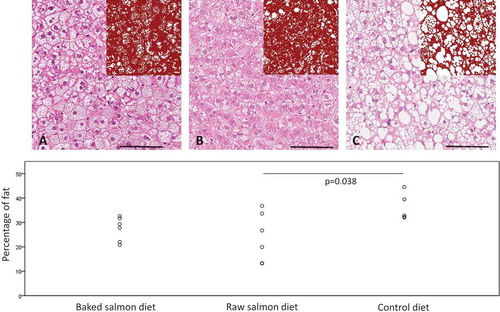Figures & data
Table 1. Composition of diets.
Table 2. Contents of indispensable amino acids, the functional amino acid glycine, the conditionally essential amino acid arginine, taurine, ratios of lysine/arginine and methionine/glycine and fatty acids* in the diets (g/kg diet).
Table 3. Body weight at baseline, growth and organ weights relative to body weight at time of euthanasia, energy intake and faecal output one week before euthanasia.
Table 4. Concentrations of serum lipids, bile acids, vitamin D, MG-BSA and CML-BSA.
Table 5. Concentrations of lipids in liver and skeletal muscle (thigh), and lipids and bile acids in 24 h faecal output.
Figure 1. Representative images from liver sections showing steatosis in the groups fed with baked salmon diet (A) and raw salmon diet (B) compared to steatosis in the control group (C) (stain hematoxylin-eosin, scale bars 100 micrometer). Insets in the upper right corner display marked-up images for image analysis. The graph shows percentage fat content calculated by image analysis for individual rats.

Table 6. n-3 and n-6 PUFAs in serum, liver, skeletal muscle and epididymal white adipose tissue.
